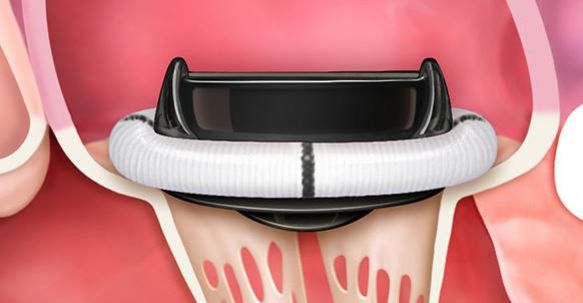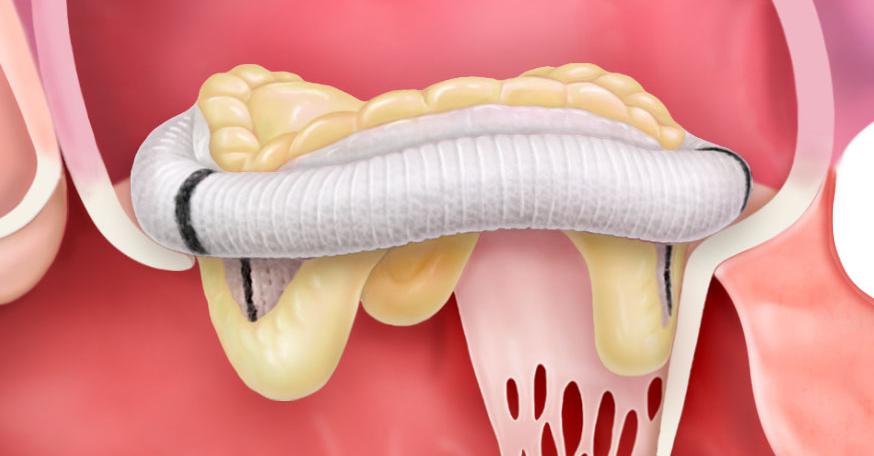Mitral Regurgitation
TREATING MITRAL REGURGITATION BEFORE IT PROGRESSES
Mitral regurgitation (MR) places an extra burden on the heart and lungs, and the heart may have to work harder to function normally. The mitral valve is a heart valve that lies between the left atrium and left ventricle. The valve opens and closes to ensure that blood flows in only one direction. In mitral regurgitation, the valve does not close completely and blood leaks backward (regurgitates) into the left atrium.1 The more open the valve remains, the more blood regurgitates and the more severe the problem.
Symptoms of mitral regurgitation
It is possible for a person to have mitral regurgitation without experiencing any symptoms. In some cases, some of the following symptoms may be experienced:

Fatigue or inability to exercise

Sensation of feeling the heart beat (palpitations) or a rapid heartbeat

Dry, hacking cough (often worse when lying down)

Shortness of breath

Fainting

Swollen feet or ankles
What can happen if mitral regurgitation is not treated?
Mitral regurgitation places an extra burden on the heart and lungs. Over time, some people may develop an enlarged heart because it has to work harder to pump blood through the body. If it is not treated, mitral regurgitation can cause other, more serious problems with the heart, such as heart failure. This is a condition that occurs when the heart can’t pump enough blood to meet the needs of the body.1
Treatment options for mitral regurgitation
Treatment for mitral regurgitation depends on how severe the condition is, and if it’s getting worse.1,2 The goal of treatment is to improve the heart’s function while minimizing the symptoms and avoiding future complications.
- Medical management
Medications may be prescribed to help manage symptoms of mitral regurgitation, such as diuretics for fluid buildup in the legs and lungs. However, these medications only treat the symptoms and do not address the underlying problem with the mitral valve that is causing the disease.
- Mitral valve surgery
Considered the most effective long-term treatment for mitral regurgitation, surgery gives the greatest probability for a safe and effective solution over time. Several surgical procedures are available to repair or replace the mitral valve, including traditional open-heart surgery, which involves opening the sternum (with an incision over the chest and sternum), minimally invasive surgery that does not involve opening the sternum and less invasive robotic procedures.
Surgical Mitral Valve
RepairIf mitral valve repair is an option, a surgical technique called an annuloplasty may be performed. This procedure typically involves the implantation of a device to tighten or replace the ring around the mitral valve (annulus) so that the valve leaflets can close properly. When needed, other techniques may be used to repair the valve.
Surgical Mitral Valve
ReplacementIf the mitral valve cannot be repaired, valve replacement with an artificial (prosthetic) valve may be recommended. Two types of prosthetic mitral valves are available: mechanical or tissue.
- Transcatheter Mitral Valve Repair (TMVr)
TMVr, also known as TEER (transcatheter edge-to-edge repair), is a minimally invasive procedure that may be an option for patients with severe mitral regurgitation. Unlike surgery, this procedure does not require chest incisions and temporarily stopping the heart. Instead, a thin tube (called a catheter) is guided through a vein in the leg to reach the heart and mitral valve. During the procedure, a clip (or sometimes more than one clip) will be implanted onto the center of the mitral valve to help it close more completely. This reduces mitral regurgitation, and the valve continues to open and close on either side of the clip, allowing blood to flow through.
- Transcatheter Mitral Valve Replacement (TMVR)
TMVR is a minimally invasive procedure that allows a new, artificial valve to be inserted within the diseased mitral valve that is causing the mitral regurgitation. Unlike surgery, this procedure does not require chest incisions and temporarily stopping the heart. Instead, a thin tube (called a catheter) is guided directly into the heart or through a vein in your leg to reach the mitral valve. The replacement valve is then inserted through the catheter and placed within the existing mitral valve and secured in place. This new mitral valve then opens and closes properly, allowing blood to flow through the heart.
SURGICAL MITRAL VALVE REPLACEMENT
If a mitral valve cannot be repaired, valve replacement with an artificial (prosthetic) valve may be recommended. Two types of prosthetic mitral valves are available: mechanical or tissue. Each type of valve offers different benefits and risks.
Choosing between a mechanical valve or a tissue valve

Mechanical valves are made of strong, long-lasting materials such as carbon and titanium and are designed to last for the rest of the patients’ life. However, patients are required to take daily blood-thinning medication for the rest of their lives to help prevent blood clots.1,2

Tissue valves are made with tissue from pig or cow heart tissue (or a combination of the two) and can possibly last 10–15 years, requiring another surgery or procedure to replace the valve if it wears out. Tissue valves do not usually require long-term use of blood-thinners.1,2
To determine the optimal valve, a doctor will take many factors into consideration, such as age, overall health and medication requirements.1
Less than 50 years old
A mechanical valve is recommended based on a review of current clinical evidence and a discussion between a doctor and patient, especially if:
- The patient is already taking a blood thinner for another health problem
- The patient can safely take a blood thinner and is willing to do so
A tissue valve may be recommended depending on lifestyle.
Between 50 to 70 years of age
The type of valve recommended will be based on a review of current clinical evidence and a discussion between doctor and patient.
Greater than 70 years old
A tissue valve may be recommended with some exceptions depending on the clinical situation if:
- The patient does not want to take a blood thinner or cannot take it safely
- The patient is willing to have another valve replacement procedure if the tissue valve wears out
In rare cases, a mechanical heart valve may be recommended.3
The information provided is not intended for medical diagnosis or treatment or as a substitute for professional advice. Consult with a physician or qualified healthcare provider for appropriate medical advice.
MAT-2201007 v2.0 | Item approved for OUS use only.